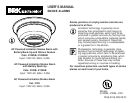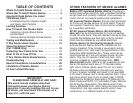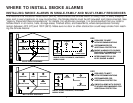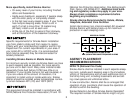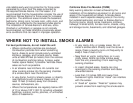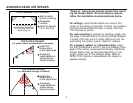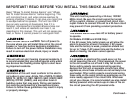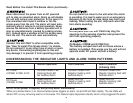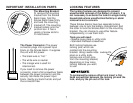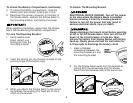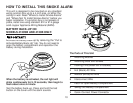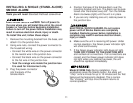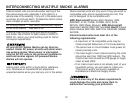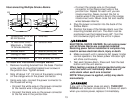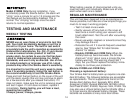
OTHER FEATURES OF SMOKE ALARMS
Battery (DC) operated Smoke Alarms: Provide pro-
tection even when electricity fails, provided the batter-
ies are fresh and correctly installed. Units are easy to
install, and do not require professional installation.
AC powered Smoke Alarms: Can be interconnected
so if one unit senses smoke, all units alarm. They do
not operate if electricity fails. Units must be installed
by a qualified electrician.
AC/DC powered Smoke Alarms: (AC with battery
back-up): Can be interconnected so if one unit senses
smoke, all units alarm. They will operate if electricity fails,
provided the batteries are fresh and correctly installed.
Units must be installed by a qualified electrician.
Smoke alarms for the hearing impaired:
Special
purpose Smoke Alarms should be installed for the
hearing impaired. They include a visual alarm and an
audible alarm horn, and meet the requirements of the
Americans With Disabilities Act. These units can be
interconnected so if one unit senses smoke, all units
alarm. They do not operate if electricity fails. Units
must be installed by a qualified electrician. BRK
Electronics® Model 100S is an AC powered unit that
has an 85 decibel alarm and a 177 candela strobe
light, which flashes rapidly when the unit is in alarm.
All these units are designed to provide early warning
of fires if located, installed and cared for as described
in the user’s manual, and if smoke reaches them. If you
are unsure which type of unit to install, refer to NFPA
(National Fire Protection Association) 72 (National Fire
Alarm Code) and NFPA 101 (Life Safety Code). National
Fire Protection Association, One Batterymarch Park,
Quincy, MA 02269-9101. Also check your local building
codes which may also require specific units in new
construction or in different areas of the home.
TABLE OF CONTENTS
Where To Install Smoke Alarms . . . . . . . . . . . . . .1
Where Not To Install Smoke Alarms . . . . . . . . . . .3
Important! Read Before You Install
This Smoke Alarm . . . . . . . . . . . . . . . . . . . . . . . . .5
Understanding the Indicator Lights
and Alarm Horn Patterns . . . . . . . . . . . . . . . . . .6
Locking Features . . . . . . . . . . . . . . . . . . . . . . . . . .7
How To Install This Smoke Alarm . . . . . . . . . . . .10
Installing a Single (Stand Alone)
Smoke Alarm . . . . . . . . . . . . . . . . . . . . . . . . .11
Interconnecting Multiple Smoke Alarms . . . . .12
Testing and Maintenance . . . . . . . . . . . . . . . . . .14
If This Smoke Alarm Sounds . . . . . . . . . . . . . . .15
Using the Silence Feature
(Cat. 4120SB Only) . . . . . . . . . . . . . . . . . . . . . . . .16
Protecting Your Family From Fire . . . . . . . . . . . .17
What To Do In Case Of Fire . . . . . . . . . . . . . . . .18
If Your Smoke Alarm Needs Service . . . . . . . . .18
Troubleshooting . . . . . . . . . . . . . . . . . . . . . . . . . .19
Special Compliance Considerations . . . . . . . . .20
Limitations of Smoke Alarms . . . . . . . . . . . . . . .21
10-Year Limited Warranty . . . . . . . . . . . . . . . . . .22
IMPORTANT!
PLEASE READ CAREFULLY AND SAVE:
This user’s manual contains important
information about your Smoke Alarm’s
operation. If you are installing this unit for use
by others, you must leave this manual—or a
copy of it—with the user.



